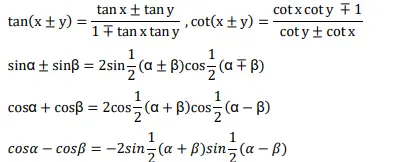Here is the CBSE Class 11 Maths syllabus
CLASS XI
(Total Periods 180)
UNIT I: SETS AND FUNCTIONS
- Sets (Periods 20)
Sets and their representations. Empty set. Finite and Infinite sets. Equal sets. Subsets. Subsets of the set of real numbers especially intervals (with notations). Power set. Universal set. Venn diagrams. Union and intersection of sets. Difference of sets. Complement of a set, Properties of Complement sets.
- Relations and Functions (Periods 20)
Ordered pairs, Cartesian product of sets. The number of elements in the Cartesian product of two finite sets. Cartesian product of the reals with itself (upto R × R × R).
Definition of relation, pictorial diagrams, domain, co-domain, and range of a relation. Function as a special kind of relation from one set to another. Pictorial representation of a function, domain, co-domain, and range of a function. The real-valued function of the real variable, domain, and range of these functions, constant, identity, polynomial, rational, modulus, signum, and greatest integer functions with their graphs. Sum, difference, product, and quotients of functions.
- Trigonometric Functions (Periods 20)
Positive and negative angles. Measuring angles in radians and in degrees and conversion from one measure to another. Definition of trigonometric functions with the help of unit circle. Truth of the identity sin2x + cos2x = 1, for all x. Signs of trigonometric functions and sketch of their graphs. Expressing sin (x+ y) and cos (x + y) in terms of sin x, sin y, cos x and cos y. Deducing the identities like following:

Identities related to sin2x, cos2x, tan2x, sin3x, cos3x and tan3x.
UNIT II: ALGEBRA
(1) Complex Numbers and Quadratic Equations (Periods 10)
Need for complex numbers, especially $\sqrt {-1}$, to be motivated by the inability to solve every quadratic equation. Brief description of algebraic properties of complex numbers. Argand plane
(2) Linear Inequalities (Periods 10)
Linear inequalities, Algebraic solutions of linear inequalities in one variable and their representation on the number line.
(3) Permutations and Combinations (Periods 10)
The fundamental principle of counting. Factorial n. Permutations and combinations derivation of formulae and their connections, simple applications.
(4) Binomial Theorem (Periods 10)
History, statement, and proof of the binomial theorem for positive integral indices. Pascal’s triangle, general and middle term in binomial expansion, simple applications.
(5) Sequence and Series (Periods 10)
Sequence and Series. Arithmetic Progression (A.P.), Arithmetic Mean (A.M.), Geometric Progression (G.P.), general term of a G.P., the sum of n terms of a G.P. Arithmetic and geometric series, infinite G.P. and its sum, geometric mean (G.M.). Relation between A.M. and G.M.
UNIT III : COORDINATE GEOMETRY
- Straight Lines (Periods 15)
Brief recall of 2-D from earlier classes, shifting of origin. Slope of a line and angle between two lines. Various forms of equations of a line: parallel to axes, point-slope form, slope-intercept form, two-point form, intercepts form and normal form. General equation of a line. Equation of family of lines passing through the point of intersection of two lines. Distance of a point from a line.
- Conic Sections (Periods 25)
Sections of a cone: Circles, ellipse, parabola, hyperbola, a point, a straight line and pair of intersecting lines as a degenerated case of a conic section. Standard equations and simple properties of parabola, ellipse and hyperbola. Standard equation of a circle.
- Introduction to Three-dimensional Geometry (Periods 19)
Coordinate axes and coordinate planes in three dimensions. Coordinates of a point. Distance between two points and section formula.
UNIT IV : CALCULUS
Limits and Derivatives (Periods 40)
Derivative introduced as rate of change both as that of distance function and geometrically. Intuitive idea of limit. Limits of polynomials and rational functions trigonometric, exponential and logarithmic functions. Definition of derivative relate it to scope of tangent of the curve, derivative of sum, difference, product and quotient of functions. Derivatives of polynomial and trigonometric functions.
UNIT V : STATISTICS AND PROBABILITY
- Statistics (Periods 20)
Measure of dispersion; Range, mean deviation, variance and standard deviation of ungrouped/grouped data.
- Probability (Periods 20)
Random experiments: outcomes, sample spaces (set representation). Events: Occurrence of events, ‘not’, ‘and’ & ‘or’ events, exhaustive events, mutually exclusive events. Axiomatic (set theoretic) probability, connections with the theories of earlier classes. Probability of an event, probability of ‘not’, ‘and’, & ‘or’ events.
You can download this from CBSE site also
